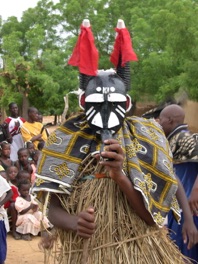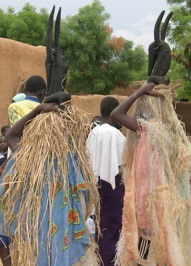DVD: bamana children’s masquerades, kirango (Mali)



By Elisabeth den Otter
Kirango is an old village on the banks of the Niger river, 35 km from Ségou.
The village is inhabited by Bamanan (farmers) and Bozo/Somono (fishermen). Both ethnic groups celebrate
their masquerades, each in their own way. In June every year the Bamanan organize a masquerade, which
comprises dances, masks and ‘sogow’ (literally animals), large puppets that represent animals, symbolic
or domestic. They are accompanied by drumming and singing. A few weeks after the masquerade of the
adults, the children of the Sokalakin and Ndenadin quarters organize their own masquerades; they make
and manipulate the masks and puppets themselves.
The children's masquerade of the Sokalakin quarter starts with a boys' dance:
'Sogodunun' (the rhythm of the animal), followed by the Marabout who has been to Mecca, 'El Haj Mori': a
masked dancer accompanied by two 'pupils'. Then two masked dancers, dressed as women, represent
'Jubali', Bozo women who are always late. The 'Ciwara' mask represents an antelope, symbol of the strong
young farmer; this mask is accompanied by a group of boys who imitate the work in the fields. The
'Ndomo' mask relates to the first phase of the initiation societies of the Bamanan; the boys -who are
not yet circumcised- prepare and eat a lizard. The past of the village is represented by a sketch,
'Cekorobafoli', the dance of the Old Man; he is accompanied by boys who prepare traditional medicines,
Peul girls carrying calabashes filled with milk, a Bamanan girl carrying a wooden bowl with millet
porridge, and a boy carrying a sacrificial goat. 'Jinè', a frame covered with cloth, with a rod puppet
in the shape of the head of an antelope, represents a Devil or Genie. The last animal, 'Sama' (the
Elephant) is made from cloth and manipulated from within by two boys.
A week later, the children of the Ndenakin quarter celebrate their
masquerade. First, boys of one family prepare their animals, in their courtyard: the Chameleon
('Noonsi'), the Little Witch ('Sumusonin'), and the Sheep ('Saga'). They are made of cloth or straw.
Their masquerade starts with two Nasty Chimpanzees ('Gonfarinmanw'), followed by a sketch representing
the rowdy jokers ('Koredugaw') of the initiation society Kore. Next comes the Bush Spirit ('Wokulonin'),
a mask representing a night genie, a feared hunter armed with a bow and arrow. An elegant antelope,
'Ndegenin', is a frame covered with cloth and straw. The mask 'Papu' (diminutive of the name Yacuba) is
a young masked dancer accompanied by two girls, who perform a fashionable dance.
The last animal of the afternoon is the Wild Animal ('Warabacaco'), made from
cloth and manipulated from within by two boys.
The dvd consists of two parts:
1) an introduction (slide series with explanation)
2) a film (41 minutes)
N.B.: The liner notes are in French.
Film, photos, texts and production: Elisabeth den Otter
Samaké Records 03, 2006 ©
➤Home

